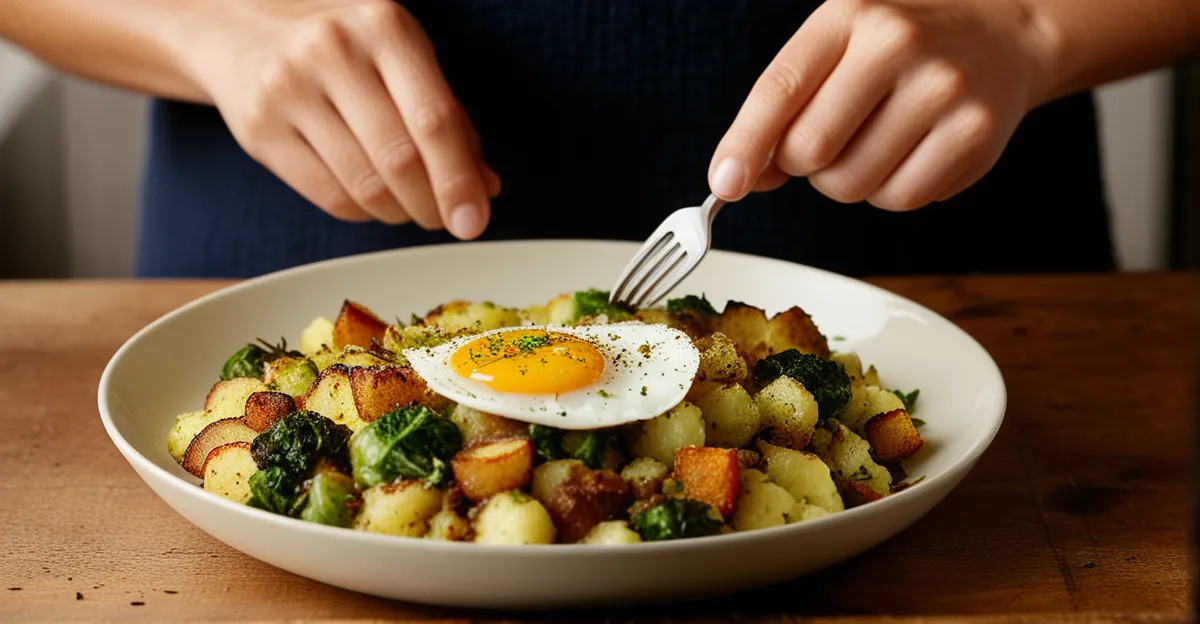Step-by-step recipe for traditional bubble and squeak
Discovering an authentic bubble and squeak recipe starts with the right balance of simple ingredients. Traditionally, this dish combines cooked potatoes and cabbage—two staples of British home cooking. For a classic version, you will need:
- 500g of mashed potatoes
- 300g of cooked cabbage, roughly chopped
- 2 tablespoons of butter or dripping for frying
- Salt and black pepper to taste
Begin by ensuring both the potatoes and cabbage are cold or at room temperature, which helps in achieving the right texture. In a large bowl, gently mix the potatoes and cabbage, seasoning with salt and pepper.
In parallel : What are some creative ways to serve a full English breakfast?
Next, heat the butter or dripping in a heavy frying pan over medium heat until melted and hot. Shape the mixture into even patties or simply spoon it directly into the pan, pressing down to form a compact cake. Cook for about 10 minutes on one side until it forms a golden-brown, crispy crust—the “bubble” sound often heard is where the dish gets its name.
Carefully flip the bubble and squeak to cook the other side for an additional 8 to 10 minutes. The goal is a nice crisp outside while maintaining a comforting, soft interior. This contrast in texture and flavour is key to enjoying traditional bubble and squeak.
Topic to read : What Makes British Cuisine Unique in Today’s Culinary World?
To enhance the dish further, avoid overcrowding the pan, which can prevent that golden crust. Using butter instead of oil adds richness, but for variation, some prefer a mix of butter and oil for optimal frying.
With this step-by-step bubble and squeak process followed closely, you’ll recreate an authentic slice of British comfort food, perfectly crispy and full of nostalgic taste.
Making the most of leftovers with bubble and squeak
Leftovers are at the heart of a great bubble and squeak recipe, turning yesterday’s roast vegetables into a delicious new meal. Traditionally, bubble and squeak leftovers include cold mashed potatoes and cabbage, yet other vegetables like Brussels sprouts, carrots, peas, and even parsnips work wonderfully. The key is to use cooked vegetables that hold their shape and moisture well, ensuring the final dish is neither too dry nor mushy.
When using leftovers for bubble and squeak, it’s best to combine them in proportions similar to the classic recipe—around 500g of potatoes to roughly 300g of vegetables—to maintain the right texture. Gently mash or chop larger pieces to create a cohesive mixture that will crisp evenly during cooking.
Proper storage is crucial for enjoying your bubble and squeak leftovers later. Place any remaining portions in an airtight container and refrigerate for up to three days. For longer preservation, freezing is possible: flatten the mixture in a freezer-safe tray or container to speed up thawing and maintain texture. When it’s time to reheat bubble and squeak, thaw overnight in the fridge and reheat slowly in a pan over medium heat, using a little extra butter if needed. This method ensures the classic crispy crust is preserved rather than steamed away, keeping the dish’s signature crunch and flavour intact.
Reheating by frying again is often preferred. Press the reheated mixture firmly into the pan, cooking each side for 5 to 7 minutes until golden brown. This technique revitalizes the bubble and squeak recipe, making leftovers taste freshly cooked while preserving that ideal contrast of crisp outside and tender inside.
Serving suggestions and comfort food appeal
Discover the true charm of serving bubble and squeak by pairing it with classic British accompaniments that elevate its comforting appeal. Popular sides include crispy fried eggs, sausages, baked beans, or even a dollop of tangy brown sauce—each adding layers of flavour and texture that complement the bubble and squeak recipe perfectly.
Presentation plays a key role in emphasizing its status as a beloved comfort food recipe. Serving bubble and squeak in individual golden-brown patties, garnished with fresh herbs like parsley or chives, adds a touch of colour and freshness. For a homely feel, plate the dish alongside vibrant grilled tomatoes or sautéed mushrooms, creating a balanced and visually inviting meal.
This versatile dish fits comfortably into breakfast, brunch, or dinner occasions. For breakfast or brunch, pair it with eggs and smoky bacon to satisfy morning hunger with hearty warmth. At dinner, it makes a filling side alongside roasted meats or stews, where its crispy texture provides a delightful contrast. Exploring these bubble and squeak accompaniments invites you to enjoy the dish as a wholesome, satisfying experience any time of day.
Origin and variations of bubble and squeak
Bubble and squeak has deep roots in British comfort food, tracing back to the 18th century when it was a practical way to use up leftover vegetables, especially after a Sunday roast. Its name is thought to come from the sounds made during frying—the bubbling of the potatoes and the squeaking of the cabbage as they cook. This dish embodies the resourceful spirit of traditional British households, turning simple, available ingredients into something warming and satisfying.
Over time, dish variations have emerged across regions and families, reflecting local tastes and available produce. While the classic recipe centers on potatoes and cabbage, many variations introduce other vegetables like Brussels sprouts, carrots, or leeks. In some areas, minced meat or ham might be added for extra flavour and substance. These adaptations showcase the flexibility of the bubble and squeak recipe, welcoming creativity while maintaining its comforting character.
Moreover, the dish’s enduring popularity lies in how it reflects comforting home cooking traditions. From modest working-class meals to nostalgic family gatherings, bubble and squeak continues to symbolize warmth, frugality, and the joy of simple flavours brought together in one dish. This heritage encourages cooks to experiment while honouring a beloved culinary legacy.





